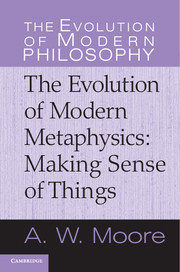Book contents
- Frontmatter
- Contents
- Preface
- Introduction
- Part One The Early Modern Period
- Part Two The Late Modern Period I
- Chapter 8 Frege
- Chapter 9 The Early Wittgenstein
- Chapter 10 The Later Wittgenstein
- Chapter 11 Carnap
- Chapter 12 Quine
- Chapter 13 Lewis
- Chapter 14 Dummett
- Part Three The Late Modern Period II
- Bibliography
- Index
Chapter 9 - The Early Wittgenstein
The Possibility, Scope, and Limits of Sense; or, Sense, Senselessness, and Nonsense
from Part Two - The Late Modern Period I
Published online by Cambridge University Press: 05 June 2012
- Frontmatter
- Contents
- Preface
- Introduction
- Part One The Early Modern Period
- Part Two The Late Modern Period I
- Chapter 8 Frege
- Chapter 9 The Early Wittgenstein
- Chapter 10 The Later Wittgenstein
- Chapter 11 Carnap
- Chapter 12 Quine
- Chapter 13 Lewis
- Chapter 14 Dummett
- Part Three The Late Modern Period II
- Bibliography
- Index
Summary
Why Two Wittgensteins?
Ludwig Wittgenstein (1889–1951) famously produced two masterpieces, both enormously influential, but strikingly different from each other in style, approach, and even, it seems, doctrine: first the Tractatus, in his youth, and later the Investigations, towards the end of his life, having in the interim been through a long period of philosophical inactivity. It is commonplace, in fact, to refer to ‘the early Wittgenstein’ and ‘the later Wittgenstein’ as if to two different thinkers. It is something I myself shall do, and I shall accord a separate chapter to each.
But it would be grotesque to do so without issuing some caveats at the outset. First, there were profound continuities between Wittgenstein’s earlier thinking and his later thinking. Some commentators would say that these were far more profound than the discontinuities. Second, and as it may appear conversely – though this is arguably the same point in another guise – if one is going to divide his work into phases at all, there are grounds for not stopping at two. Thus people often refer to his ‘intermediate’ or ‘transitional’ work, meaning by this various remarks that he dictated and notes that he produced after his return to philosophy, while he was still struggling with his earlier ideas and while his later ideas were beginning to take shape. There has even recently been a call to acknowledge a ‘third Wittgenstein’, responsible, among other things, for the drafts that he wrote in the last year and a half of his life that were published posthumously as On Certainty.
- Type
- Chapter
- Information
- The Evolution of Modern MetaphysicsMaking Sense of Things, pp. 222 - 254Publisher: Cambridge University PressPrint publication year: 2011

